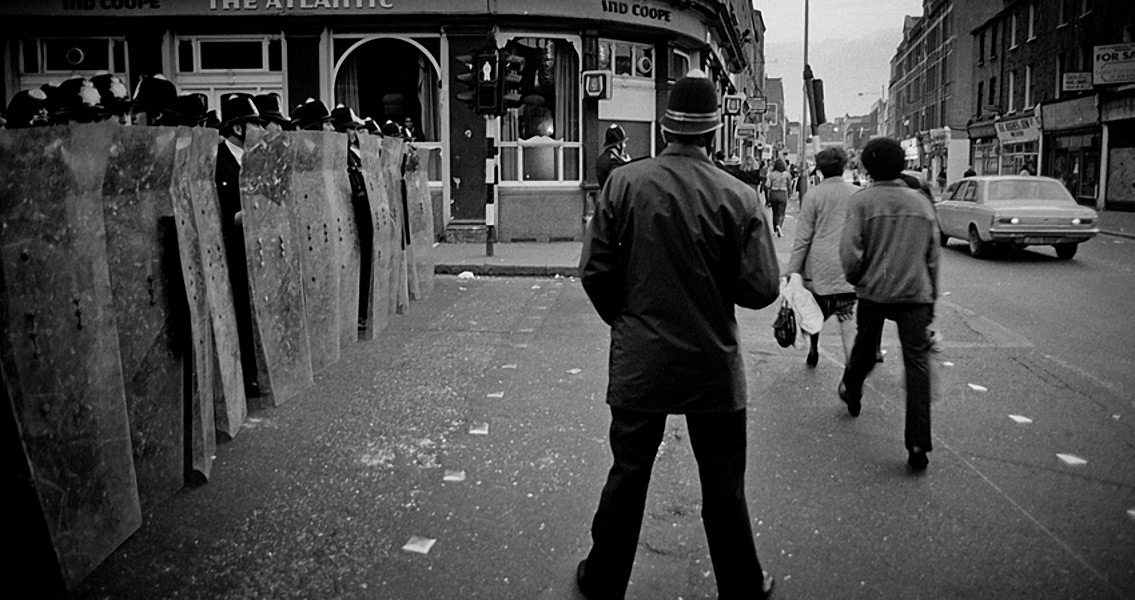<![CDATA[Thirty-five years ago, in the summer of 1981, Britain's streets were ravaged by violence and vandalism. Beginning with the infamous Brixton Riot in April, a wave of unrest spread to other cities across the country, reaching as far north as Liverpool, Manchester and Bradford. The shocking events, which reached their peak in July 1981, were symptomatic of deep rooted social and economic problems in Britain's cities, and perilous racial tensions exacerbated by discriminatory tactics by the police. The media labelled the riots the worst disturbances on the country's streets since the Second World War, with front pages showing images of overturned police vans, looted shops and petrol bombed pubs. For years tensions had been brewing in Brixton, at the time a diverse but deprived area of London. The recession of 1981 had hit the Borough of Lambeth's substantial African-Caribbean population particularly hard, triggering mass unemployment and forcing many to live in poor quality housing. A house fire in January 1981, in nearby New Cross, saw a number of black youths killed. Some believed that the fire, far from an accident, had been the result of a racially motivated arson attack and anger quickly spread at the unwillingness of the police to investigate the possibility. Adding to the growing discontent in the Borough of Lambeth, and Brixton in particular, came Operation Swamp, a police initiative that allowed officers to stop and search anyone they deemed to be acting suspiciously. The operation was initiated in response to the escalating crime rate in the area, a consequence of the wave of unemployment, but claims soon came from members of the African-Caribbean community that they were being unfairly targeted, an accusation which was supported by later reports into the origins of the Brixton Riot. On the night of 10th April, the situation reached breaking point. Police officers came across Michael Bailey, a black youth who had been stabbed. Accounts vary as to exactly what happened, but a crowd of around 50 African-Caribbean youths felt that the police were not seeking the medical help Bailey needed and confronted them. Over the next few days the situation spiraled out of control, violence and fire taking over the streets as police clashed with protesters. By the 12th April, 224 people had been arrested in the mayhem, and hundreds injured. The Brixton Riot is the most commonly remembered event of the long, hot summer of 1981, but it was just the start of a series of shocking explosions of civil unrest, suggesting the violence and protests were representative of deep lying, nationwide problems. On 3rd July, in Southall, West London, racist skinheads attending a gig in the area started to vandalise shops, abusing an Asian shopkeeper and smashing his store window among other acts of violence. A massive gang of young Asians took to the streets in the area, and descended on the pub where the gig was to take place. Riot police were deployed, to separate the two angry mobs, but petrol bombs were thrown at the pub and police cars were overturned. This wave of dangerous rioting wasn't just limited to London. On 4th July, violence erupted in Toxteth, Liverpool. After police were prevented from arresting a black man on a motorbike by an angry crowd, the situation swiftly escalated. Cars were overturned, barricading off entire streets and allowing the rioters to overpower riot police. In Manchester, the day after unrest in Toxteth came to a close, more riots erupted. At the height of the unrest, 1000 youths attempted to storm the city's Moss Side Police Station. Crucially, the Hytner Report into the Moss Side Riot stated that youths in Manchester had been provoked by the police, officers using racially abusive language among other tactics to incite the violence. It's a fact which provides critical context to the shocking events of the summer of 1981. The official investigation into the Brixton Riot led by Lord Scarman and published the following year made a similar, if much broader conclusion, stating that the events were a spontaneous response to "racial disadvantage that is a fact of British life". As Alex Wheatle, eighteen years old and living in Brixton at the time of the riots, told The Huffington Post in 2013. “When we pleaded and screamed and cried that police were abusing us in police cells no one listened. As far as we were concerned [Thatcher] was head of a racist government.” The summer of 1981 was a shockingly violent one, but its crucial to understand that from Brixton to Moss Side the riots and protests were far more complicated than just explosions of criminality and violence. Economic recession, the consequences of Thatcher’s extremely conservative policies and a growing feeling among non-white communities that the police were just another outlet of a fundamentally racist system, were enough to see the country’s streets littered with petrol bombs and riot gear. ]]>
The 1981 Summer of Riots – From London to Manchester
